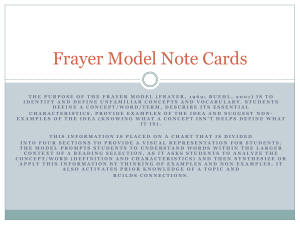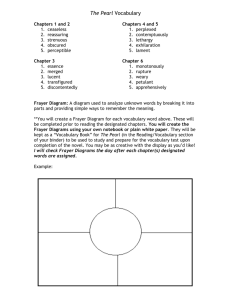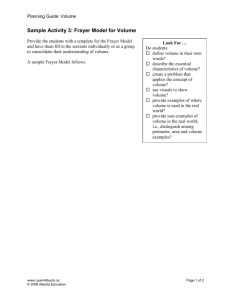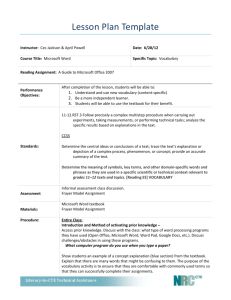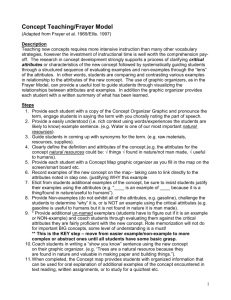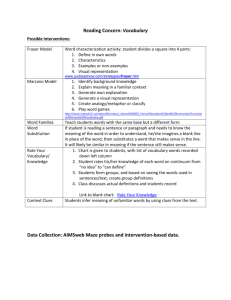Vocabulary Instruction that Builds Comprehension
advertisement
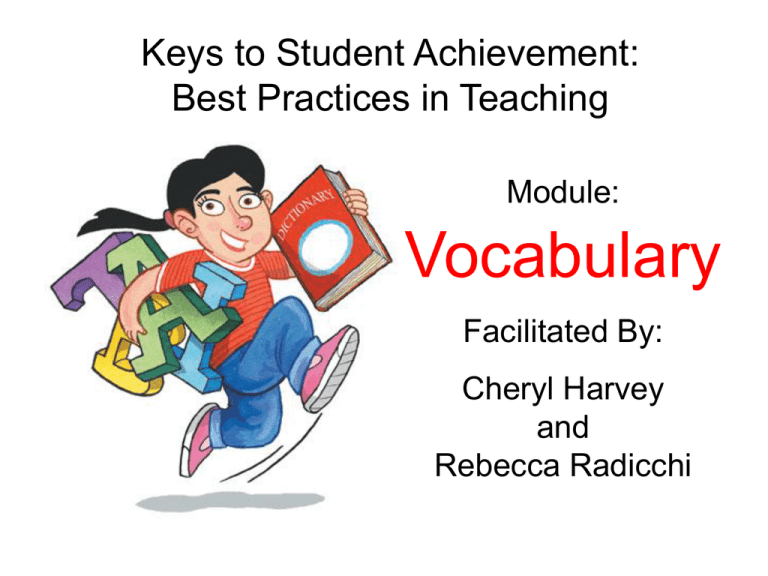
Keys to Student Achievement: Best Practices in Teaching Module: Vocabulary Facilitated By: Cheryl Harvey and Rebecca Radicchi This session is based in the Vocabulary “Best Practices” module designed by Metro RESA. How confident do you feel about your vocabulary instruction? On a scale of 1 – 9, how confident are you about your vocabulary instruction? Place a post-it on the scale on the wall– 1 is the lowest & 9 is the highest. 1 5 9 Adapted from Dale, Rasband, Ross, Gardner, & Cunningham, 2004 Essential Questions: Why is vocabulary instruction so important? What are exemplary strategies for vocabulary instruction? A little boy was in a relative’s wedding. As he was walking down the aisle, he would take two steps, stop, and turn to the crowd. While facing the crowd, he would put his hands up like claws and roar. So it went, step, step, ROAR, step, step, ROAR, all the way down the aisle. As you can imagine, the crowd was near tears from laughing so hard. The little boy was getting more and more distressed from all the laughing, and he was also near tears. When asked what he was doing, the child sniffed and said, “I was being the Ring Bear!” What level of vocabulary knowledge is evident in this child’s response? LEVEL 1 Unknown LEVEL 2 Acquainted LEVEL 3 Established Beck, McKeown, & Omanson, 1987 How do you teach vocabulary? • Discuss your response with a partner. • Group leader should be prepared to share with everyone. Word knowledge is much more than word identification or even definitional knowledge– “It takes more than definitional knowledge to know a word, and we have to know words in order to identify them in multiple reading and listening contexts and use them in our speaking and writing.” (Allen, 1999) Research on the importance of vocabulary instruction: There is an estimated 4,700 word difference in Vocabulary instruction is vocabulary knowledge one of the essential between high- and lowelements for literacy SES. (Nagy and Herman ,1984) development for students “at risk.” ( RAND Reading Study Group, 2002, NRP, 2000) For English language learners the “achievement gap” is primarily a vocabulary gap. (Carlo, et.al., 2004) Word Knowledge is Multifaceted Know it well, can explain it, use it Know something about it, can relate it to a situation Have seen or heard of the word Do not know the word schema prosody morpheme schwa automaticity diphthong dyslexia Beck, McKeown, & Kucan, 2002 Comprehensive Vocabulary Instruction Rich language learning environment ( including Read-Alouds) • Wide and Varied Independent Reading • Direct Vocabulary Instruction Reading Aloud • Students retain more vocabulary when the teacher explains critical vocabulary terms in context during the reading. • Reading a book several times leads to more word learning than reading several books once each. Reading Aloud "The single most important activity for building the knowledge required for eventual success in reading is reading aloud to children." (Becoming a Nation of Readers, 1985) Collaborative Pairs • What are the advantages of reading aloud to students? • How do read-alouds support vocabulary development? Comprehensive Vocabulary Instruction • Rich language learning environment (including Read-Alouds) Wide and Varied Independent Reading • Direct Vocabulary Instruction Reading Volume of 5th-grade Students of Different Levels of Achievement Achievement Percentile Minutes of Reading Per Day Words Per Year 90th 40.4 2,357,000 50th 12.9 601,000 10th 1.6 51,000 (Allington, 2001; Adapted from Anderson, Wilson and Fielding, 1988.) Independent Reading: Accounts for one-third or more of vocabulary growth. • How do you show your students that independent reading is great & joyful? • How do you make independent reading time meaningful? • What obstacles do you need to overcome? Center for the Study of Reading, Urbana, IL Comprehensive Vocabulary Instruction • Rich language learning environment ( including ReadAlouds) • Wide and Varied Independent Reading Direct Vocabulary Instruction Vocabulary Instruction Direct teaching of vocabulary can help improve comprehension when we follow these guidelines (Cooper, 1993): • A few critical words are taught. • The words are taught in a meaningful context. (including nonlinguistic representations) • Students relate the new words to their background knowledge. • Students are exposed to the words multiple times. You Try It! • Using the text provided, collaborate with group members and decide on the most important words to teach. • Provide a rationale for your selection. • Share! “Which words should I teach?” • Which words are most important to understanding the text? • How much prior knowledge will students have about the word/concept? • Is the concept significant and therefore requires previewing? • Which words can be figured out from the context? • How can I make repeated exposures to the word/concept enjoyable and meaningful? What are exemplary strategies for vocabulary instruction? Background Knowledge “The relationship between vocabulary knowledge and background knowledge is explicit in research.” (Nagy & Herman, 1984; Marzano, 2004; Hart & Risley, 1995) Powerful Zebras HO Word Sorts hurricanes • Provide students with a set of vocabulary word cards (related to a specific concept or topic). • Work in groups to sort the words into categories. • Encourage students to find more than one category for the vocabulary words. • Students then discuss with teacher & peers their rationale for categorizing words. Schwartz & Raphael, 1985 What is it? What is it like? To move regularly from one region to another moving around relocating traveling migrate people working for seasonal jobs birds Nomads What are some examples? Frayer Model (Frayer, Frederick, & Klausmeier, 1969) Definition a congregation of wild animals Characteristics • Group • Like animals • Clustered herd Examples Non-Examples Frayer Model (Frayer, Frederick, & Klausmeier, 1969) Definition Characteristics • 2 is the only even prime number A whole number with exactly two divisors (factors) • 0 and 1 are not prime Prime Examples 2, 3, 5, 7, 11, 13, 17, ... •Every whole number can be written as a product of primes Non-Examples 1, 4, 6, 8, 9, 10. . . Words Nutrition Ballyhoo Context Predicted Definition cereal box Important ingredient in food Confirm billboard To advertise in loud manner ? MATHEMATICS NAME SYMBOL Line Line Segment CRISS (2004) pg. 146 KEY WORD .B Plane Point LABEL .A .C Dot .M . .K 2-D or Flat .L Straight DEFINITION (OWN WORDS) A plane is a flat surface like the top of my desk. A point has no dimension, just a location. Group together to make lines. A line is a set of points determined by any 2 points. Reading with Word Explanation • Read the book/text once with minimal explanation. • After an initial reading, we can interrupt up to 8-10 times to explain words while rereading (possibly less, depending on length) • With very young children, don’t interrupt more than once per page. • Keep explanations simple~ explain only what is needed to understand the content being read in everyday language. Four Square Response Term Illustration humidity Definition a degree of wetness especially of the atmosphere Connection Concept Circles Which word does not belong? Rectangle Cone Hexagon Trapezoid Why? ___________________________________________________ racism stereotyping Church bombing violence Concept: Civil Rights Movement Vocabulary Strategies for ELL • Preview texts for unfamiliar or difficult words and the use of idiomatic language. To reduce students’ frustration, such words and expressions can be taught prior to the lesson. • Use extensive modeling and visual representations– e.g., pantomime, graphic organizers, pictures, hands-on materials. • Emphasize meaning rather than pronunciation CORE, 2000 4-2-1 Summarizer Four Two One Rogers, et.al (1999). Motivation and Learning. . . Pictionary Using only a piece of paper and pen, draw and get your partner to say these words. Los Angeles New York Miami Chicago Assessing Vocabulary Instruction • Ongoing • Varied, Meaningful & Authentic Use word wall • Do you see them using words in writing and speaking? How do you keep words you teach directly fresh in their minds and internalized? •Vocabulary word review tub •Center with former words •Keep ongoing list of words with guided reading groups •Use words in classroom talk •Word wall Finding definitions and writing those words in sentences have had little apparent impact on their word knowledge and language use. Janet Allen, 1999 Assessing Integration & Meaningful Use Sample “test” questions: • One of our target words for this week was preposterous. What kind of in-school behavior would the principal think was preposterous? • Describe a time when you felt liberated. What was the reason for that feeling? • The concept we have been studying this week is stereotyping? Give an example of what you think is stereotypical behavior. Why do you think the behavior was stereotypical? Dictionary Use When students have been provided dictionary definitions and asked to create sentences or answer brief questions about the words, research has shown: • 63 percent of the students’ sentences were judged to be “odd” (Miller & Gildea, 1985) • 60 percent of students’ responses were unacceptable (McKeown, 1991; 1993) 3 x 3 Vocabulary word knowledge dictionaries direct instruction reading with explanation background knowledge strategies Frayer Nonlinguistic representations assessment Adapted from Guilford County Schools, 2002 Essential Questions: Why is vocabulary instruction so important? What are exemplary strategies for vocabulary instruction? Web Resources for Vocabulary Practice • • • • • Vocabulary.com Vocabulary Builders Super Kids Word Scrambler Online Vocabulary Games Quia (Insert your words) Resources • Best Practices Research: Metro RESA • Clipart: Jeff Shelly and Google Images
